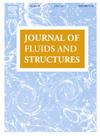A penalization-based strong partitioned coupling with application to cavitation-induced damage
IF 3.4
2区 工程技术
Q1 ENGINEERING, MECHANICAL
引用次数: 0
Abstract
A novel strong partitioned coupling strategy is developed in order to address Fluid–Structure Interaction (FSI) problems. The Brinkman penalization method is adopted to model the deformable fluid–solid interface on a fixed Cartesian grid. Originally designed for single-phase flows and rigid bodies, the penalization method is extended to compressible multiphase flows and deformable walls. This numerical model is applied to the analysis of cavitation-induced damage at the microscopic scale, focusing on the shock-induced collapse of a single bubble near an elastoplastic material. We examine the effect of initial bubble–wall distance on wall pressure, material damage and permanent wall deformation (i.e., cavitation pit). This parametric study is conducted for different material yield strengths. Both pit depth and area increase rapidly as the bubble–wall distance and yield strength decrease. Whereas closer bubbles generate a deep, circular pit, more distant bubbles can produce a shallower, annular pit. The effect of FSI coupling is thoroughly analyzed across all parametric configurations. Wall deformation results in the damping of wall pressure, leading to differences in material damage between weakly and strongly coupled simulations. At the moment of impact, the damping of wall pressure is initially governed by the ratio of the acoustic impedances of the fluid and solid media. It is then further amplified locally by plasticity or, more generally, in regions of higher deformation. A small reduction in wall pressure leads to a much more significant damping in both pit depth and pit area. While the decrease in wall pressure is locally affected by material deformation, the change in pit size remains approximately constant for all configurations.
基于惩罚的强分区耦合及其在空化损伤中的应用
为了解决流固耦合(FSI)问题,提出了一种新的强分区耦合策略。采用Brinkman惩罚法在固定笛卡尔网格上对可变形流固界面进行建模。最初设计用于单相流和刚体的惩罚方法,扩展到可压缩多相流和可变形壁面。将该数值模型应用于微观尺度上的空化损伤分析,重点研究了弹塑性材料附近单个气泡的冲击破裂。我们研究了初始气泡壁距离对壁压、材料损伤和永久壁变形(即空化坑)的影响。对不同材料屈服强度进行了参数化研究。随着泡壁距离的减小和屈服强度的减小,坑深和坑面积迅速增大。距离较近的气泡会产生深的圆形凹坑,而距离较远的气泡会产生浅的环形凹坑。在所有参数配置中,对FSI耦合的影响进行了彻底的分析。壁面变形导致壁面压力衰减,导致弱耦合和强耦合模拟中材料损伤的差异。在冲击时刻,壁面压力的阻尼最初由流体和固体介质的声阻抗之比决定。然后,它在局部被塑性进一步放大,或者更一般地说,在高变形区域。壁面压力的微小降低会导致坑深和坑面积的显著阻尼。虽然壁面压力的降低受到材料变形的局部影响,但对于所有配置,凹坑尺寸的变化几乎保持不变。
本文章由计算机程序翻译,如有差异,请以英文原文为准。
求助全文
约1分钟内获得全文
求助全文
来源期刊

Journal of Fluids and Structures
工程技术-工程:机械
CiteScore
6.90
自引率
8.30%
发文量
173
审稿时长
65 days
期刊介绍:
The Journal of Fluids and Structures serves as a focal point and a forum for the exchange of ideas, for the many kinds of specialists and practitioners concerned with fluid–structure interactions and the dynamics of systems related thereto, in any field. One of its aims is to foster the cross–fertilization of ideas, methods and techniques in the various disciplines involved.
The journal publishes papers that present original and significant contributions on all aspects of the mechanical interactions between fluids and solids, regardless of scale.
 求助内容:
求助内容: 应助结果提醒方式:
应助结果提醒方式:


